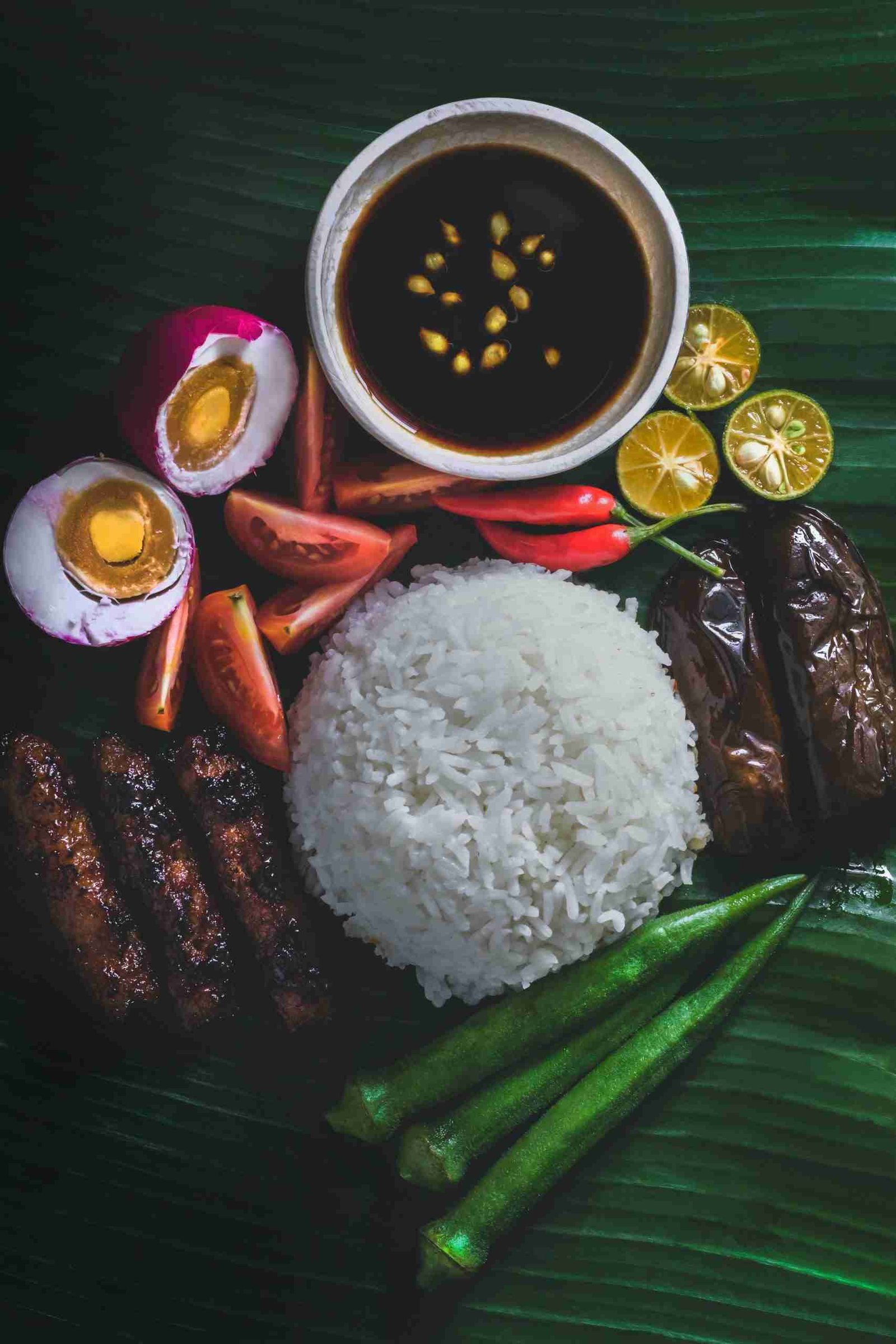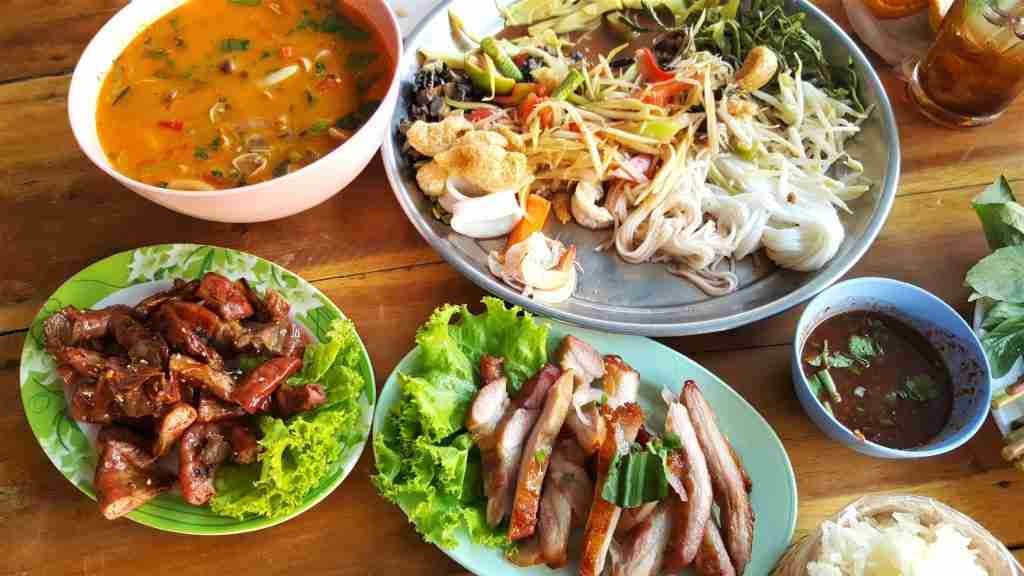
1. Adobo
Adobo, a beloved Filipino dish, consists of meat (usually chicken or pork) marinated and stewed in vinegar, soy sauce, garlic, and bay leaves. This unique combination of caramelized sugar, coconut vinegar, gives adobo its distinct sweet-sour flavor profile. national dish, Philippines, popularity, widespread Revised sentence: Its widespread popularity has led to it being considered the national dish of the Philippines.
The cooking process involves marinating the meat in a mixture of vinegar, soy sauce, and spices before stewing it until tender. This method not only infuses the pork with delicious flavors but also results in a melt-in-your-mouth texture that is characteristic of adobo.
In Manila’s vibrant food scene, numerous restaurants and cafes offer their own interpretations of this classic dish. Whether you’re exploring tasting menus at upscale eateries or seeking out authentic street food experiences, adobo is a staple feature on many menus across the city.
For those looking to try their hand at creating this iconic Filipino cuisine at home, there are countless recipes available online that cater to different dietary preferences such as vegetarian or vegan variations using tofu or vegetables instead of meat.
Adobo’s versatility extends beyond just being served as a standalone dish; it can also be used as a flavorful filling for tacos or sandwiches. The depth of flavor achieved through slow-cooking makes it an ideal addition to various culinary creations.
2. Halo-halo
Halo-halo, a beloved Filipino dessert, is a delightful concoction of crushed ice, evaporated milk, sweet beans, jellies, fruits, and topped with ube (purple yam) ice cream. This vibrant mix offers a symphony of delicious textures and flavors that make it an irresistible treat.
The name “halo-halo” originates from the Tagalog phrase meaning “mix-mix,” which perfectly encapsulates the essence of this dessert – the act of stirring all the ingredients together before indulging in its refreshing goodness.
This iconic Filipino dessert is not only a feast for the taste buds but also provides respite from Manila’s sweltering heat. It’s often found in food stalls across the city and can be customized to suit individual preferences by adding ingredients like coconut or leche flan.
3. Lechon
Lechon is a festive dish known for its crispy skin and tender meat. This Filipino food is often the centerpiece of celebrations and special occasions in the Philippines, showcasing the country’s rich culinary tradition. The most famous lechon dish can be found in Cebu, where it’s cooked over an open flame for several hours.
In Cebu, they use banana leaves to encase the entire pig while roasting, infusing it with a subtle yet distinct flavor that sets it apart from other variations across the Philippines. This method creates a unique aroma and taste that locals and tourists alike find irresistible.
Chef Chele González, whose restaurant Vask showcases modern Spanish cuisine with Filipino influences, has also incorporated lechon into his menus. His innovative take on this traditional dish has made him one of Manila’s favorite chefs among locals and visitors.
The capital city of Manila boasts some of the best restaurants serving lechon—each offering a slightly different experience for those eager to savor this iconic Filipino fare.
Whether enjoyed at restaurants or in quaint local eateries around the city, lechon continues to hold its place as one of Manila’s must-try dishes—a testament to its enduring popularity within Philippine cuisine.
4. Balut
Balut, a fertilized duck egg with a partially developed embryo inside, is a popular delicacy in the Philippines. Often consumed as street food or a snack, it’s known for its unique taste and texture.
Many locals consider balut to be an aphrodisiac due to its supposed ability to enhance libido. This belief has contributed to its popularity among both locals and tourists seeking out exotic culinary experiences at restaurants.
In Manila, balut can be found in various places such as wet markets or sold by street vendors throughout the city. It’s often enjoyed with a sprinkling of salt or vinegar, enhancing the overall flavor profile of this traditional Filipino dish.
Despite being an acquired taste for some, balut remains an integral part of Filipino cuisine and culture. Its consumption reflects the adventurous spirit of food enthusiasts exploring Manila’s best restaurants as a vibrant food destination.
5. Kare-kare
Kare-kare is a traditional Filipino stew that features oxtail, tripe, and vegetables bathed in a rich peanut sauce. This dish offers a unique blend of flavors and textures, from the tender meat to the creamy nuttiness of the sauce.
Accompanied by bagoong, a fermented shrimp paste served on the side, kare-kare delivers an explosion of umami and depth to each bite. The contrasting taste of the bagoong complements the richness of the peanut sauce, elevating the overall dining experience.
The combination of savory meats and velvety peanut sauce makes kare-kare a beloved comfort food in Manila. The best food at restaurants is not just about sustenance; it’s about savoring every spoonful as it wraps you in warmth and nostalgia.
When visiting Manila, trying kare-kare is essential for experiencing the best Filipino food. Whether enjoyed at local eateries or renowned restaurants known for their exceptional rendition, this iconic dish promises an unforgettable gastronomic journey through Filipino culinary heritage.
6. Sinigang
Sinigang, a beloved Filipino dish, is a sour soup known for its tangy tamarind base and diverse meat or seafood options like pork, shrimp, or fish. The sourness of sinigang primarily comes from tamarind but can also be derived from other sources such as calamansi or green mangoes.
This hearty and flavorful food is a staple in Filipino cuisine and offers a delightful burst of flavors in every spoonful. It’s often enjoyed with a side of rice to balance out the tartness of the food.
The versatility of sinigang allows for various food ingredients to be added based on personal preferences; common additions include spinach, radish, eggplant, or string beans. This flexibility makes sinigang an adaptable dish that can cater to different tastes and dietary needs.
Sinigang’s unique blend of savory and sour flavors has made it popular not only within the Philippines but also among food enthusiasts worldwide. Its refreshing taste profile has contributed to its widespread appeal and recognition as one of the must-try dishes when visiting Manila.
7. Sisig
Sisig, a sizzling dish made from parts of pig’s head and liver seasoned with calamansi and chili peppers, is a must-try food when visiting Manila. This iconic Filipino dish is often served on a hot plate, creating a distinctive sizzling sound that adds to the overall dining experience.
The bold flavors and unique preparation of sisig have contributed to its popularity not only in the Philippines but also internationally. Its combination of savory, tangy, and spicy flavors has captured the attention of food enthusiasts worldwide.
In Manila, visitors can find various versions of sisig and other Filipino food across different restaurants and eateries. From traditional recipes to modern interpretations, each place offers its own take on this beloved dish. At Seascape Village in Pasay City or Pampanga’s Best House of Sisig in Quezon City, one can explore diverse variations of sisig that cater to different preferences.
Whether it’s the classic version or an innovative twist, sisig remains a top recommendation for those looking to immerse themselves in Manila’s vibrant culinary scene.
8. Taho
Taho, a popular sweet snack in Manila, is made from fresh soft tofu, arnibal (sweet syrup), and sago pearls (tapioca pearls). It’s a warm and comforting food enjoyed by many Filipinos as part of their breakfast or mid-morning snack. Vendors carrying large containers balanced on poles can be seen selling food in the streets during the morning.
This iconic Filipino delicacy embodies the rich cultural heritage of Manila and offers an authentic taste of local street food. Its simple yet delightful combination of flavors and textures makes it a must-try for anyone visiting Manila.
The sight of vendors skillfully balancing their taho equipment while calling out to potential customers adds to the unique charm of experiencing this traditional snack. The process of preparing taho right before your eyes creates an immersive experience that allows you to take a step back in time and appreciate the authenticity behind this beloved dish.
9. Pancit Palabok
Pancit palabok is a Filipino noodle dish that boasts a unique blend of flavors and textures. Topped with thick savory shrimp sauce, crushed chicharrón (pork cracklings), tinapa (smoked fish), shrimp, and hard-boiled eggs, this dish offers a symphony of tastes in every bite.
This iconic Filipino noodle dish is not only delicious but also visually appealing. Its vibrant presentation makes it a staple during fiestas and gatherings, where its presence signifies celebration and togetherness.
The combination of the umami-rich shrimp sauce, the crunchiness of chicharrón, the smoky flavor from tinapa, and the tender sweetness of shrimps creates an explosion of taste that has made pancit palabok a favorite among locals and visitors alike.
In essence, pancit palabok represents more than just food; it embodies the rich culinary heritage and communal spirit deeply embedded in Filipino culture.
10. Turon
Turon, a beloved Filipino snack, is created by wrapping slices of ripe plantains and strips of jackfruit in spring roll wrappers before deep-frying until golden brown. This process results in a delightful blend of sweet fruit filling encased in crispy layers, making it a popular street food choice.
The snack is commonly coated with caramelized sugar that gives it a sweet crunch, adding an extra layer of flavor and texture to the already delicious treat. This combination of flavors and textures makes turon an irresistible option for those with a sweet tooth.
In Manila, turon is widely available from street vendors and local eateries, offering both residents and visitors easy access to this delectable snack. Its popularity not only stems from its taste but also from its affordability, making it accessible to people from various walks of life.
Moreover, turon’s portability makes it an ideal on-the-go snack for busy individuals or tourists exploring the vibrant streets of Manila. Its convenient handheld form allows people to enjoy it while strolling through markets or taking in the city’s sights.
With its simple yet satisfying ingredients and preparation method, turon encapsulates the essence of Filipino street food culture – flavorful, affordable, and easily accessible for everyone to enjoy.
Frequently Asked Questions
What is Adobo?
Adobo is a popular Filipino dish made with meat, usually chicken or pork, marinated in vinegar, soy sauce, and spices. It’s then simmered until tender and flavorful.
How does Halo-halo taste like?
Halo-halo is a delightful mix of sweet treats like fruits, beans, jellies, shaved ice topped with milk and ice cream. It’s a refreshing dessert that offers a unique combination of textures and flavors.
What is Lechon?
Lechon is a traditional Filipino dish featuring whole roasted pig with crispy skin and succulent meat. It’s often the centerpiece of festive celebrations due to its rich and savory flavor.
What exactly is Balut?
Balut is a fertilized duck egg typically boiled and eaten from the shell. The embryo inside may be partially developed which adds an interesting texture to this delicacy enjoyed by many Filipinos.
How does Kare-kare taste like?
Kare-kare is a rich stew made with oxtail, tripe, vegetables in peanut-based sauce. Its unique nutty flavor combined with the tenderness of the meat makes it an exquisite culinary experience.



